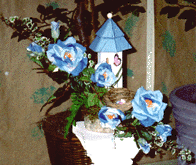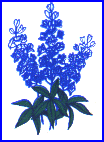
Any bunch of flowers stuck in a glass jar looks good and brightens a room but how much nicer is a well arranged floral bouquet? In Basic Florals we will show you how to achieve this end with the least difficulties. You will not be told to place a rose at 3:00 or 5:00 o'clock but will be shown basic sizes and shapes that allow you to design floral presentations using what you have on hand or those flowers you like.
You will need some specialized equipment. We suggest a small carrier similar to the ones sold to hold cleaning supplies to keep all your supplies in. With this pick up and go you are ready to make an arrangement at a moments notice.

The mechanics of your arrangement, that part that holds the arrangement in place according to your design, can also use marbles, chicken wire, pins, wired picks and decorative objects.
Types of Florals
There are four main color schemes that are used in floral design. The first is Monochromatic. This means that all material in the arrangement will be shades of a single color (greenery and Babys' Breath can be added without changing the monochromatic designation). The complementary color schemes provide the most contrast and uses those colors directly opposite on the color wheel. The adjacent color scheme uses any three colors adjacent to each other on the color wheel. The triadic color scheme includes those colors that fall at the three points of an equilateral triangle placed on the color wheel. This is the most difficult arrangement to establish since a slight variation could cause a jarring rather than an appealing arrangement.
Besides the actual color the effect of dark and light must be considered. The darker shades will appear recessed while the lighter will appear to come forward. This can be used effectively especially in the monochromatic arrangement.
In the floral arrangement you will need to consider not only the shape of the individual components but the final shape of the arrangement. It is usually best to limit the number of shapes you incorporate in your arrangement to avoid confusion. Conversely an entire arrangement of only one shape can become monotonous.
We can provide additional interest in your design by varying the textures from smooth to rough. The arrangement should also flow from one element to the next providing periodic resting places for your eyes with the highlighting of individual floral elements.
Our next considerations are the principles of design. Every artistic discipline incorporates these principles. Beginning with your focal point a feeling of balance and stability is formed as you build your arrangement from this point. The arrangement should have a smooth flowing look regardless of the angle from which it is viewed. Each arrangement will have the main or mass as its focal point. This is not necessarily always at the center front bottom of the arrangement but it is the point that becomes the visual base. As we demonstrate each of the different shapes of arrangements this base or focal point will be easily discernible.
The scale or proportion of the floral elements of an arrangement must work together to make a pleasing whole. Scale is the actual size of the elements whereas the proportion refers to the relationship between the different elements. In this area we include not only the floral elements but also the container and any enhancements such as the addition of ribbons, bows, figurines and the like.
The entire arrangement should provide for a smooth flow of the eye from one highlight to the next. This rhythm in design is achieved with the colors, the line, contrast and repetitions used within your design. Contrast highlights the differences between the elements from the dark to the light, from the smooth to the rough and the tight firm flower head to the light airy babys' breath.
Using all these design elements provide us with arrangements that should naturally have a dominant or focal point. After you have designed and built your arrangement you should be able to see the dominant area. If it has not developed naturally it is time to add an additional flower that greatly contrasts or something else that brings a dominant point to the arrangement.
Another element in floral design that must be considered is the container. Virtually anything can be used as a container. The only requirements are if using fresh flowers that it will hold the oasis and water. When making a vertical arrangement the floral element should be one and one half the height of the container where a horizontal arrangement will be one and one half times the width of the container.
Traditional Arrangements

Some of the traditional floral shapes are:


In the individual instructions we may name some flowers but understand that it is shape of flower and substitutions can be made by any like shape so use what you have or if you will have to purchase flowers purchase those that you like. A rose, carnation, chrysanthemum, daisy, camellia and anemone are all interchangeable as the flower of choice for the given arrangement.
In addition to the traditional shapes listed above we will also cover topiaries, basic wreaths and swags. Just for fun we have added meanings for some of the flowers so that an arrangement could deliver a message, some flower conditioning if you are working with fresh flowers from your yard and other flower trivia.
Ivy is often added to the bridal bouquet or wedding decorations since it is the symbol of a happy marriage. Click on the "Flower Meanings" below to find some other floral meanings.
Click HERE for directions on making a Floral Bow.
Click HERE for Flower Meanings

The Bluebonnet is a Lupin and in the Victorian Language of Flowers, Lupin means imagination. Because of our location in Texas and the meaning we chose the Texas State Flower, the Bluebonnet, for our company name and logo.


Bluebonnet Crafters
Bluebonnet Village Craft Network
http://www.BluebonnetVillage.com/
Crafty College is a division
of the Internet Visions Company.
© 1998, Internet Visions Co. All rights reserved.
All trademarks are owned by Internet Visions Company.